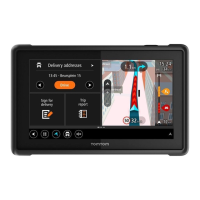Features on the TomTom Bridge
The TomTom Bridge uses the Android operating system. TomTom and the device owner have
changed the operating system in the following ways:
Certain Android features have been disabled, either by TomTom or by the device owner. This
makes the device safer and easier to use while driving.
Some new features and apps have been added, both by TomTom and by the device owner.
These additions customise the device so it is relevant for the functions it will be used for.
The features added by TomTom are as follows:
Important: For other settings and operation instructions for the TomTom Bridge, and for instruc-
tions about other apps installed on the TomTom Bridge, please refer to the applicable User
Documentation.
Sleep settings
You can choose when your TomTom Bridge goes to sleep if no apps are running or when it is
removed from its dock.
Open Display in the Android Settings app to see the following settings:
Sleep
Sets the delay time before your Bridge goes to sleep if no apps are running.
Stay awake when docked
Keeps your Bridge awake while it is docked and there is power.
Sleep automatically when disconnecting from power
Puts your Bridge to sleep when power is removed either from the dock or directly from the
Bridge.
Memory card slot
The TomTom Bridge has a memory card slot that is located on the bottom of the device. You can
use a memory card to access your personal files, for example photos or music files.
Transferring files to your device
You can transfer personal files, for example POI lists, photos or music files, to the TomTom Bridge
internal memory. This allows you to use apps on the device to view POIs, photos or play music.
You can also transfer files from the Bridge internal memory to your computer.
Note: Not all file types can be opened by the device.
Note: You can transfer files from a computer running one of the following operating systems:
- Windows 7 or higher
- Apple OS X 10.5 or higher
- Some Linux distributions of version 14.04 or higher.
To transfer files, do the following steps:
1. Connect the Bridge to your computer using the USB cable supplied with your Bridge, then switch
your Bridge on.
Note: Use ONLY the USB cable supplied with your device. Other USB cables may not work.
Note: You cannot use the mount to connect your device to your computer.
Note: You should plug the USB cable directly into a USB port on your computer and not into a
USB hub or USB port on a keyboard or monitor.
2. On your computer, open a file manager program.
Your Bridge appears in your computer's files system as TomTom Bridge.

